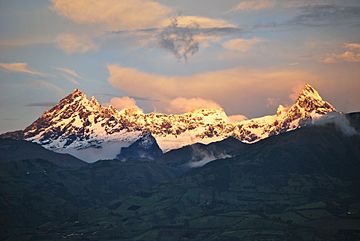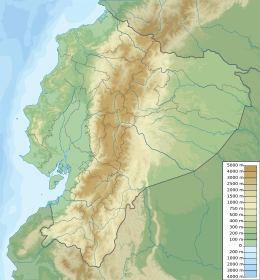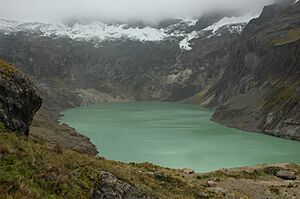El Altar facts for kids
Quick facts for kids El Altar |
|
|---|---|
| Capak Urcu | |

El Altar in 2006
|
|
| Highest point | |
| Elevation | 5,319 m (17,451 ft) |
| Prominence | 2,072 m (6,798 ft) |
| Listing | Ultra List of volcanoes in Ecuador |
| Geography | |
| Parent range | Andes |
| Geology | |
| Age of rock | Pliocene-Pleistocene |
| Mountain type | Stratovolcano (extinct) |
| Last eruption | Unknown |
| Climbing | |
| First ascent | 7 July 1963 by Marino Tremonti, Ferdinando Gaspard and Claudio Zardini |
| Easiest route | rock/ice climb |
El Altar is a huge, extinct volcano located in Ecuador. It's also known as Capac Urcu, which might come from the Kichwa language and mean "principal" or "great mountain."
This impressive volcano is found on the western side of Sangay National Park, about 170 kilometers (105 miles) south of Quito. Its highest point reaches 5,319 meters (17,451 feet) above sea level. When Spanish explorers first saw it, they thought its peaks looked like a church altar with nuns and friars around it. That's how it got its name, El Altar, which means "The Altar."
Contents
What is El Altar?
El Altar is a type of volcano called a stratovolcano. This means it was built up over a long time by many layers of hardened lava, ash, and rock. It formed during the Pliocene and Pleistocene periods, which were millions of years ago.
The Volcano's Crater Lake
The top of El Altar has a large, bowl-shaped hollow called a caldera. This caldera formed when the volcano's summit collapsed, likely after a huge eruption.
The caldera is shaped like a horseshoe and is about 3 kilometers (1.9 miles) wide. Inside this giant basin, there's a beautiful crater lake at about 4,200 meters (13,780 feet) high. This lake is known as Laguna Collanes or Laguna Amarilla.
Ancient Inca legends say that the top of El Altar collapsed around the year 1460 after seven years of volcanic activity. However, geologists, who study the Earth, believe the caldera is much, much older than that.
Visiting El Altar
El Altar is a popular spot for adventurers, but it's also very challenging.
Climbing the Peaks
Climbing the highest peaks of El Altar is considered one of the most difficult climbs in Ecuador. The route to the highest summit, El Obispo, is very tough and requires advanced climbing skills. The best time for experienced climbers to try an ascent is from December to February.
Hiking to the Lake
A more accessible adventure for many people is hiking to the beautiful lake inside the volcano's caldera.
To get there, you can take a bus from the city of Riobamba to a town called Candelaria. From Candelaria, you need to check in at the ranger station to enter Sangay National Park.
The trail to the lake can be very muddy, so it's a good idea to wear knee-high rubber boots! The hike to a nearby refuge, called Hacienda Releche, takes about 4 to 7 hours. This refuge has beds and a kitchen, and you can rent it for your stay. From the refuge, it's another 1.5 to 2 hours of hiking across a valley and up a steep hill to reach Laguna Collanes.
Peaks of El Altar
El Altar has nine main peaks that form the horseshoe shape around the central lake. These peaks are named after parts of a church altar, like "Bishop" and "Nun." Here are the names of the peaks, starting from the highest one on the south side and going counterclockwise:
| Peak name | Meaning | Height | Direction from lake | First time climbed |
|---|---|---|---|---|
| Obispo | Bishop | 5,319 m (17,451 ft) | South | July 7, 1963, by Ferdinando Gaspard, Marino Tremonti, Claudio Zardini |
| Monja Grande | Great Nun | 5,160 m (16,929 ft) | Southeast | August 17, 1968, by Bill Ross and Margaret Young |
| Monja Chica | Small Nun | 5,080 m (16,667 ft) | East-Southeast | January 16, 1971, by Peter Bednar and party |
| Tabernáculo | Tabernacle | 5,180 m (16,995 ft) | East | |
| Fraile Oriental | Eastern Friar | 5,060 m (16,601 ft) | East-Northeast | September 28, 1979, by Fernando Jaramillo, Danny Moreno, Luis Naranjo, Hernán Reinoso, Mauricio Reinoso and Marcos Serrano |
| Fraile Beato | Devout Friar | 5,050 m (16,568 ft) | East-Northeast | |
| Fraile Central | Central Friar | 5,070 m (16,634 ft) | Northeast | |
| Fraile Grande | Great Friar | 5,180 m (16,995 ft) | North-Northeast | December 1, 1972, by Lorenzo Lorenzi, Armando Perron, Marino Tremonti |
| Canónigo | Canon | 5,260 m (17,257 ft) | North | March 7, 1965, by Ferdinando Gaspard, Lorenzo Lorenzi, Marino Tremonti, Claudio Zardini |
See also
 In Spanish: Volcán El Altar para niños
In Spanish: Volcán El Altar para niños
- Geography of Ecuador
- List of mountains in Ecuador
- List of Ultras of South America
- Lists of volcanoes
- List of volcanoes in Ecuador



